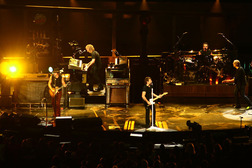NC.ELA.L.6.5
North Carolina English Language Arts Standards
Grade 6
Learning Domain: Language
Standard: Demonstrate understanding of figurative language and nuances in word meanings.
Degree of Alignment:
2 Strong
(2 users)
NC.ELA.L.8.4
North Carolina English Language Arts Standards
Grade 8
Learning Domain: Language
Standard: Determine and/or clarify the meaning of unknown and multiple-meaning words or phrases based on grade 8 reading and content, choosing flexibly from a range of strategies: context clues, word parts, word relationships, and reference materials.
Degree of Alignment:
2 Strong
(2 users)
NC.ELA.L.8.5
North Carolina English Language Arts Standards
Grade 8
Learning Domain: Language
Standard: Demonstrate understanding of figurative language and nuances in word meanings.
Degree of Alignment:
2 Strong
(2 users)
NC.ELA.RL.8.4
North Carolina English Language Arts Standards
Grade 8
Learning Domain: Reading: Literature
Standard: Determine the meaning of words and phrases as they are used in a text; analyze the impact of specific word choices on meaning and tone, including analogies or allusions to other texts.
Degree of Alignment:
2 Strong
(2 users)
NC.ELA.RL.8.1
North Carolina English Language Arts Standards
Grade 8
Learning Domain: Reading: Literature
Standard: Cite textual evidence that most strongly supports an analysis of what the text says explicitly as well as inferences drawn from the text.
Degree of Alignment:
1.5 Strong
(2 users)
NC.ELA.RL.6.1
North Carolina English Language Arts Standards
Grade 6
Learning Domain: Reading: Literature
Standard: Cite textual evidence to support analysis of what the text says explicitly as well as inferences drawn from the text.
Degree of Alignment:
1 Limited
(2 users)
NC.ELA.RL.6.4
North Carolina English Language Arts Standards
Grade 6
Learning Domain: Reading: Literature
Standard: Determine the meaning of words and phrases as they are used in a text; analyze the impact of a specific word choice on meaning and tone.
Degree of Alignment:
1 Limited
(2 users)



This assignment is the start of a good assessment. In 8th grade, poetic elements are taught but the most important thing that is missing is how the language and the poetic elements impact the tone and theme and for those of you fussing about cultural relevance...that is not addressed in the ELA standards. this project does allow students to express themselves and be proud because it is the "Music of my life", meaning they can talk about what is relevant to them. I like that they are not collaborating. That makes it a great assessment. We don't typically collaborate on summative assessment even if it is authentic like this one and not a standard test. We are watering down curriculum too much. We have to stick to the standards and hold the students accountable for learning them.
As a member of the Culturally Relevant Teaching Hub Academy, I feel that this resource has the beginnings of analysis to build critical consciousness of power, equality and justice. It does not yet contain sections to value the identity of each student. The overview mentions connecting the project to an essential question such as "How can we encourage positive change in our society"? Is the class engaging in conversations about definitions and reviewing examples for positive social change? is the assignment framed in exploring music as a powerful agent for social change in conjunction with understanding poetic elements? Have the students analyzed the power of diction/do they all have an understanding of the power words wield?
How is the class defining "meaningful"? A few examples are provided, such as how music evokes memories of 'someone special' or a 'struggle you overcame', but music has such rich cultural significance, and this assignment has much potential, but it touches the surface of what it could accomplish. The project is engaging/would capture most students' interest, but there is an opportunity for deeper connection. I like Cindy's suggestion of offering an option to collaborate, though that would not work for all students because some of our connections to music are quite personal/private.
This resource technically compares multiple perspectives, but does not address traditionally marginalized ones. The resource also does not yet present a lens of critical consciousness that also explicitly names why multiple perspectives have been historically excluded.
Also, this resource should consider accessibility in that it does not address students who may be hearing impaired. The assignment may be modified to accommodate all learners.
As a member of the Culturally Relevant Teaching Academy; I propose that this resource has the beginnings of analysis to build critical consciousness of power, equality and justice. It does not yet contain sections to value the identity of each student. In addition; this resource strongly compares multiple perspectives, including traditionally marginalized ones. The resource does not yet present a lens of critical consciousness that also explicitly names why multiple perspectives have been historically excluded
As a member of the Culturally Relevant Teaching Hub Academy I was excited to see how much choice students have in this project. They get to pick 5 songs that are important to them. In the description, I saw that these songs are sometimes linked to the theme of "change in our society" and sometimes an essay is required to explain how the songs show this theme, however, I didn't see any of that in the actual assignment. I think this assignment has massive potential for getting students thinking critically about power, equality and justice, but also their own identity through the songs they choose. They simply need some modeling for that kind of critical thinking and then be asked to do so. I also think this project could be improved upon by making it collaborative so that students could see multiple perspectives and think of ways to represent all of that.
on Oct 05, 09:06am Evaluation
Engagement: Strong (2)
This resource does not yet build critical consciousness or value the identity of the student.
on Oct 05, 09:06am Evaluation
Accuracy: Superior (3)
This resource strongly compares multiple perspectives including traditionally marginalized ones. The resource does not yet present a lens of critical consciousness that also explicitly names why multiple perspectives have been historically excluded